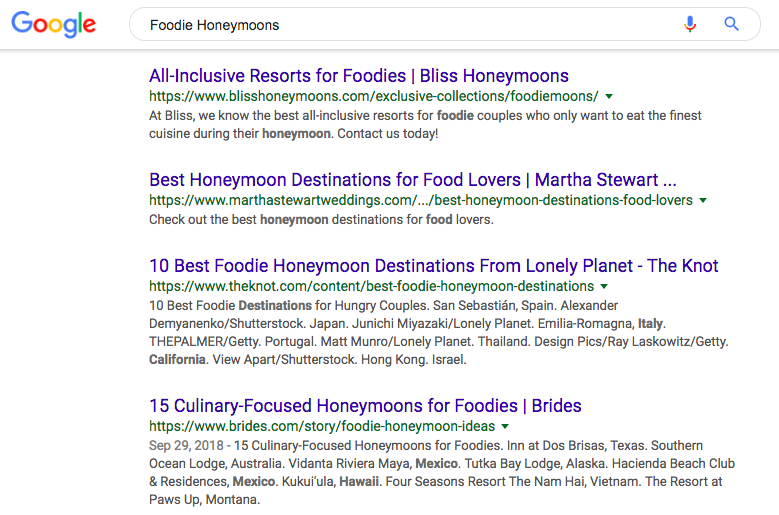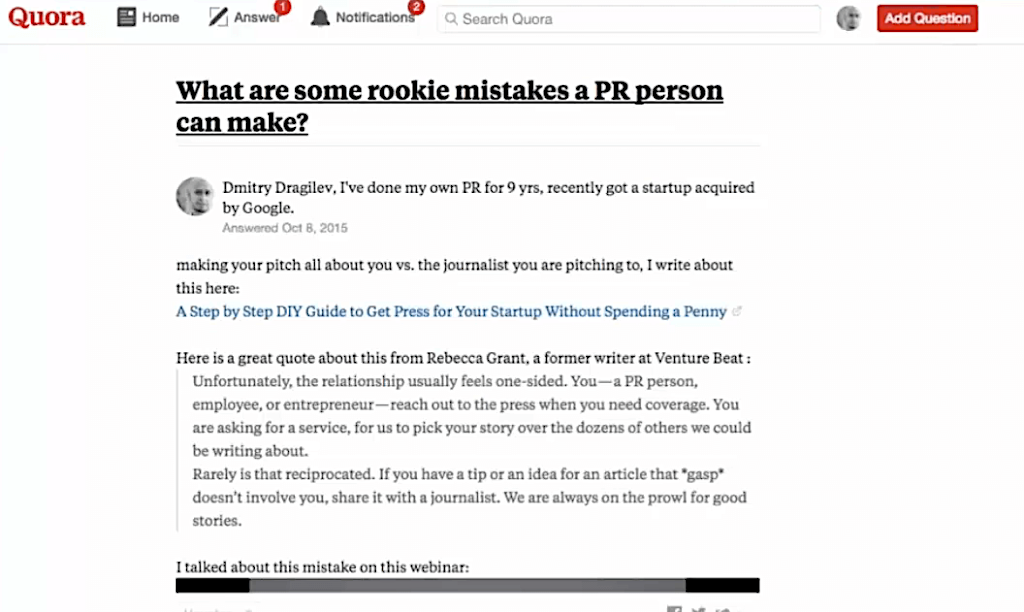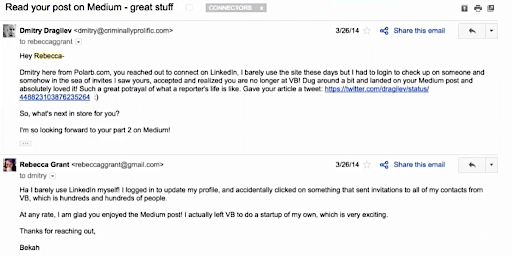You’ve spent countless days and nights perfecting your idea and building a great company. Now the time has come to let the world know about it. You are convinced that your company is so enticing that no journalist could resist writing about it.
Except that it’s not.
I’m not saying what you’re offering isn’t good—it might be absolutely brilliant. The problem is that building something brilliant usually isn’t enough to guarantee you media coverage. Sometimes less brilliant businesses get more press exposure simply by investing in an effective strategy—building strong relationships with journalists.
Put yourself in the shoes of any busy journalist who gets over a hundred emails a day asking for their time and attention. A large majority of these emails look exactly the same. They are typical mass-produced emails with an attached press release that have been bulk sent to 100+ journalists.
Who would you feel more comfortable writing about—a random stranger asking for free advertising right off the bat, or someone you’ve interacted with a few times before anything has been launched and seem to have common ground with? The answer is obvious. A strategy focused on building real, genuine relationships with journalists is something that will set you apart from the other businesses.
A great example of success with this approach is Groove. Alex Turnbull, the founder of the company, was able to generate 1,000 subscribers from a single blog post in 24 hours and drive a significant number of trial signups to his SaaS helpdesk solution—all by focusing on a relationship-building strategy.
In this post, I’ll share a 7-step process that you can follow to build strong relationships with journalists who can help you secure more headlines for your business.
Step 1: Google Articles in Your Niche
The first step is to create a spreadsheet with a list of topics or potential story angles that you can pitch to journalists. These have to be relevant to your industry.
For instance, if you have a booking platform for local food and drink tasting experiences, some of these potential pitch topics could be:
- Top Foodie Destinations in Western Europe
- Wine Experiences Worth Traveling For
- Foodie Honeymoons

Now take a topic from this list and plug it into Google or JustReachOut to find relevant newspapers, magazines and blogs that write about similar subjects where you could be featured.
For instance, if you Google ‘Foodie Honeymoon’, it will give you a list of articles that have been published on this topic on various blogs and online magazines:

Using JustReachOut in this step makes it simple, as you can contact your target journalists directly from this tool. With Google, you may have to find email addresses and other contact details manually.
Learn More:
- How to Sustainably Build Quality Links by Building Relationships
- How to Get More Responses From Cold Emails
- 5 Hacks to Start a Conversation with an Influencer
- 30 Social Media Prompts to Get the Conversation Started
Step 2: Gather Names of Relevant Journalists
The next step is to click on the articles that appear on the first few pages of your search to find names of relevant journalists and bloggers who regularly write about your industry, product and/or service. Finding the right journalist to target is an important step when building effective relationships with the media and forging connections with just any random journalist won’t work.
When going through these articles and publications, check the author’s name to see if it is a real person you can connect with. Sometimes blogs do not give author names for articles written by staff members.
If you can’t find the name of an article's author, it’s probably better to avoid this specific publication. Share on XHowever, if the publication is extremely relevant to your business or shows potential as a platform where you could contribute, don’t get completely discouraged if the article you looked up does not have an author name. Poke around the website for other posts to find another contributor you can engage with.
At this stage, just remember to target mid-tier blogs and publications before going after the big guns like NYT, CNN or National Geographic. I’m not saying you shouldn’t try to get press coverage in the top-tier publications, but you want to establish some credibility first with smaller media outlets before going up the rung.
Step 3: Make a List of Targets
This step has to be done in conjunction with Steps 1 and 2.
In your spreadsheet, make a separate tab—Media List. The Media List tab will have 5 columns:
- Name of publication
- Link to the article related to your topic,
- Name of the editor/writer
- Pitch title,
- Conversation starter
It will look something like this:

You can also add columns for the email address, Twitter handle, and areas of interest for the journalist. You will use these pieces of information in later steps.
As you read each article from your Google search results in Step 1, go through this checklist:
- Is the post written by a real person you can connect with?
- Is the author still writing for this publication?
- Is the readership of the blog or publication similar to your target demographic?
- Can you find a unique, insightful point to make about this article that can be used as a conversation starter?
If the article checks all these boxes, add it to the Media List tab in your spreadsheet.
Then gather more information about your target journalist by reading their articles, following them on Twitter, reading their bios, and subscribing to their personal blogs (if they have one). The important goal here is to know not only which topics, niche or industry they cover, but also the focus of their articles—is it only political topics or do they also cover startup stories and business growth stories?
You can use all this information to strike up an initial conversation with the journalist before you send any kind of formal pitch email.
Learn More:
- Cold Email Templates that Get Responses
- 8 Quick Tips to Ensure SEO-Friendly Emails
- Beyond the Newsletter: You’ve Got Their Email, Now What?
- Email Marketing Myths & Truths: How to Enhance Your Email Marketing Strategy
Step 4: Find Your Conversation Starter
Now you must find common ground between what you want to pitch and the interests of the specific journalists that you discovered in Step 3 that you can use as a good conversation starter.
Here’s how to do this.
Carefully read each post that is related to your pitch topic. In the previous step, you made an initial assessment about whether you could find a unique or interesting point in the post that could be used to strike a conversation. In this step, you now dive into the details to actually find that interesting analysis, insight or fact.
Here are some things you could look out for:
- Are the facts in the article old or dated?
- Can you provide updated facts?
- Is there some missing information?
- Can you provide a fresh perspective or insight into the post?
Add these ‘conversation starters’ to your Media List tab in the spreadsheet.
Remember: For each potential pitch topic, follow Steps 1-4 at least 10 times.
You can now use these conversation starters to send an email to your target journalist to initiate a dialogue. However, it is recommended that you get on their radar first by going through Steps 5-7. This will ensure that your first email does not get relegated to junk or spam.
Step 5: Share on Social
A simple like or retweet on Twitter can show your appreciation for a journalist’s work—and since you’re working with people who are relevant in your industry, it’ll also be valuable to your own audience. You can also mention the journalist in a relevant tweet and then use that to start your conversation when sending a pitch email.
Another thing to do is make a thoughtful comment on their article or blog post. The comment should either have an interesting point or question that gets their attention. Just saying “this is a great article” will not get you any brownie points, so this is where all the information you gathered from the earlier steps come into play.
A good rule of thumb is to share two of their tweets or comment on two of their blog posts or online articles before moving to the next step. This will ensure that the journalist remembers your name and you start off on the right note.
Step 6: Compliment Their Work
Compliments are one form of interaction that journalists are always ready to engage with. That’s why this step will build on your retweets and comments to lodge your name permanently in the mind of your target journalist.
And the best part? You don’t need to specifically find stories associated with your niche to compliment them. You can use an article that your target journalist wrote recently or even for an award that they or their publication won.
Use this simple email format:
Hey John,
Just saw your article on [marketing automation]. Loved the point you made about how [less than 10% of companies are using autoresponders based on website behavior effectively].
Looking forward to your next article.
Dmitry
It’s simple, but effective.
Learn More:
- The 8 Best Outbound Sales Automation Tools for Cold Emailing
- The Email Marketer’s 4-Step Guide to GDPR Compliance
- How AI Helps Add Personalization to Your Email Campaigns
Step 7: Mention Them on Quora and Follow Up
The next step is to use Quora to increase the engagement.
This is how you do it: Enter your target keyword in Quora and choose a question that warrants an expert opinion. In your answer, include a reference or quote from the journalist that you’re trying to connect with.
For example, when I wanted to connect with a Venture Beat writer, I included her quote in my answer:
 That’s just the first step though. Journalists aren’t scouring through forums to find mentions of themselves, so you’ll need to inform them of it. You can reach out through email or Twitter and let them know why you mentioned them in the first place:
That’s just the first step though. Journalists aren’t scouring through forums to find mentions of themselves, so you’ll need to inform them of it. You can reach out through email or Twitter and let them know why you mentioned them in the first place:
 This tactic shows the journalist that you care enough about their work to not only read it, but to also promote it on a platform you don’t even own—enabling you to form a long-standing relationship.
This tactic shows the journalist that you care enough about their work to not only read it, but to also promote it on a platform you don’t even own—enabling you to form a long-standing relationship.
Optional Steps when Connecting with Top Journalists
1) Share a relevant piece of content related to a recent article they wrote
Share relevant articles, reports, videos, white papers or any other content related to an article that a journalist recently wrote to start a discussion.
Crucial tip: Do not send any content related to your business, or anything that you have created.
Here is a simple template you can use (making sure to proofread for spelling and grammar, of course!):

Keep these pointers in mind when using this step:
- If possible, try and open with a mutual connection. Having a mutual contact establishes some credibility, reducing your chances of ending up in the trash folder.
- Make sure you link to the article you’re mentioning. Providing immediate context to what you’re referring to is always a good idea.
- Make sure the content you are sharing is useful and relevant. I cannot stress how important this is. If you’re writing an email to help a writer, you’d better make sure that the information is actually helpful.
2) Meet in-person and share your business card
There is nothing like face-to-face interactions, especially when trying to connect with top journalists and reporters from mainstream media. It’s even better to attend industry conferences or open house discussions to meet with the press personally. This might seem like a tough one and may not be possible for everyone, but it is doable.
Journalists are always happy to build new connections in the industry or niche they write about, and industry conferences are a great place to share your business cards and start an initial conversation.
You can use this later to send an email to your target journalist, pointing out that you met them at an industry event. This is an easy way to get the ball rolling.
Learn More:
- Buyer’s Journey 101: What Your Email Data Says About Your Customers
- How to Grow Your Business With Influencer Marketing
- How Artificial Intelligence Is Transforming Influencer Marketing
Final Step – Make Your Pitch
Well, that’s it. You have made contact with your target journalist. They know a bit about you, and you have a conversation flowing.
Keep this momentum going! Continue talking to them through various mediums and then make a formal pitch when you have a story to tell.
Conclusion
Building relationships with journalists is an overlooked part of generating successful press coverage. It can seem difficult to master since you’re dealing with humans, not metrics, but it’s not too much effort, considering the payoff.
Use the seven-step process outlined in this post and you will be able to build meaningful relationships with journalists quickly and easily.
If you need additional ideas for email templates, here are 17 useful email scripts from my friends at Groove that have helped them build relationships with journalists, influencers and customers.






